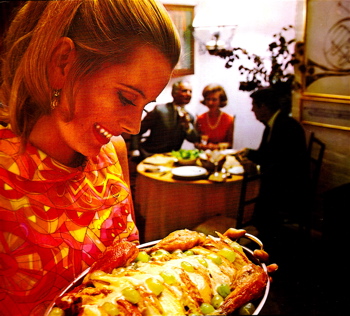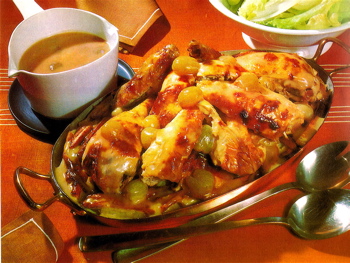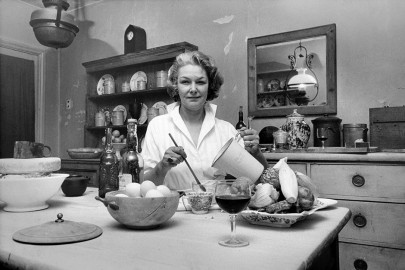In the first of a small series, London-based dabbler Luke Honey, maître d‘ of The Greasy Spoon Blog, resurrects a venerable cookery magazine, complete with a retro recipe that has long since fallen out of favour…
Not that long ago I managed to save a complete set of the 1968 Cordon Bleu Cookery Course, all 72 of ’em in a near mint condition. A friend at work was about to chuck them away into the skip. They make fascinating reading: a time-warp into a familiar, but very different age.
I’m amused by the photograph from the very first issue, which I’ve posted above. A youngish couple are having the in-laws to dinner. For the first time at the new flat? There’s bound to be a bay tree and carriage lamp outside the glossy front door. Daddy’s very much the silver-haired roué, the clubbable chairman (something in plastics?) Bet you anything he drives a Jag, and keeps a mistress holed up in a tiny flat in Dolphin Square. He’s holding forth while his long-suffering wife (Jackie Kennedy shift-dress and pearls) sits patiently, “Yes, Dear, No, Dear, Three Bags Full, Dear”.
Youngish Hubbie looks like an International Man of Mystery; probably a thrusting young exec. If he plays his cards right, Daddy might get him a directorship at the family firm. Our heroine’s a secretary at some fashionable advertising agency somewhere. J Walter Thompson? Though God Knows how she finds the time to cook: the Cordon Bleu Cookery Course is quite clearly aimed at women who don’t go out to work; the draconian instructions include a precise timetable for operations: 8.43am Light the Oven, 9.59am Truss the Chicken. That sort of thing. The couple’s London pad is slightly trendy- the Victorianesque French Horn print is very Conran. And what is she gazing at so proudly? It’s none other than our old friend, Chicken Véronique!
Here’s how to make the dish, with precise instructions from the Cordon Bleu Cookery School, 1968.
First, you need to season the inside of a trussed chicken, but you’re not allowed to season the outside, as the salt will “draw out the juices, and prevent browning. (Hang on! Is this really true? Simon Hopkinson does. Not sure about that one). The trussed bird will keep its shape, and be easier to carve. (Yup, that sounds right).
Next, you rub the chicken with butter, and put 3-4 sprigs of tarragon inside, along with a further nut of butter. The chicken is placed in a roasting tin, with ¼ pint of chicken stock, covered with buttered paper, and roasted for an hour at 400° F. After the first 15 to 20 minutes, the chicken should be removed from the oven and basted; and then basted again after another 15-20 minutes, turning the chicken around, each time. The buttered paper should be removed a few minutes before the end of the cooking, to brown the bird.
The hot chicken is then removed to a wooden board, jointed and carved. The remaining juices in the roasting tin are reduced over a steady heat until “brown and sticky”. Another ¼ of a pint of chicken stock is added to the pan to make a gravy, which is then strained into a small saucepan and thickened with ½ teaspoon of arrowroot mixed with a tiny bit of water. (Add the arrowroot mixture away from the heat, and then stir until boiling). Two tablespoons of double cream are stirred into the gravy.
Peel and pip some white or muscat grapes (you can blanche them in boiling water to help the process), and drop them into the gravy. The chicken pieces are arranged on a silver-plated oval-shaped serving dish, the gravy is spooned all over it, and the grapes scattered over the chicken. The remaining gravy and grapes (not sure about keeping the grapes in the gravy, very odd) are served separately in a sauceboat.
Chicken with Gravy. Served with Grapes. What do you think? The way forward, or a definite step backwards?
Next time on “Food in the Sixties”: Len Deighton and Cooking for Men: Making Food Sexy












Lovingly cradled… Looks like she’s just given birth to Veronique.
Shouldn’t they be fasting on Ash Wednesday?
Excellent social analysis. I wonder in which gentrifying area – Islington, Notting Hill at the Holland Park end? – the flat is situated. Perhaps, however, they didn’t need to be blockbusters and daddy’s wedding present was something in Chelsea.
I have a horrible moment of deja vu wherein I recall my mother making this. She certainly had (some of) the Cordon Bleu course. The stimulus for this is not remotely Proustian but your descriptive reduction: ‘Chicken with Gravy. Served with Grapes.’ Much as I love for instance the confections of Wodehouse’s peerless Anatole (‘Timbale de Riz de Veau Toulousaine’ etc etc), perhaps the description of all recipes should be similarly clarified.
Don’t think it’s going to be Notting Hill. Not in 1968. I lived there in the 80’s and it was pretty dodgy (people would react in horror, when you told them), although I agree the Holland Park end (near Julie’s) might be a possibility. Islington, likewise, or Canonbury. but as it’s 1968 I would point a long finger towards South Kensington. It was more affordable back then, and the former haunt of the acid bath murderer still had plenty of grotty b & b’s and cheap hotels.
My parents actually have one of those large blue folders containing these magazines on a bookcase at home. I have occasionally flicked through, and been amazed at the staggering obsession with encasing nearly everything with jelly/aspic. Luckily I cant remember eating any of this kind of food as I was too young, but chicken and grapes does sound somewhat odd, although I suppose no stranger than Coronation Chicken
How right you are. You sent up for the large plastic blue box, and kept the course inside. We had the complete set. I was fascinated by it as a child, even then, partly by the wonderful sub-Victorian-esque graphics- woodcuts of game pies, musical instruments, wild boar heads on a plate. With hindsight, of course, all this stuff was extremely fashionable in that Carnaby Street, Sgt Pepper way- military uniforms, tubas, penny farthings, top hats. But like Steed’s Mews House.
Right about those ubiquitous jellied salads. Also endless casseroles, most with jarring flavour combinations. What this recipe reminds me is how many dishes combined meat and fruit. Pork with apple, mint with lamb, pineapple with ham, and here chicken with grapes. I hated them all. Anglo-American cooking had to await the discovery of garlic before main dishes became more than a hazardous waystation on the road to the safety of dessert.
I believe this was part of the post-war effort by manufacturing companies to sell refrigerators, since, apparently, we can live comfortable without them.
I enjoyed this. As a man who dabbles a bit in the sale and resale of vintage items, books included, I am fascinated by the recipes entombed in old cookbooks, and how tastes have changed. Those grapes balanced on top of the chicken look foul. I can imagine eating it and thinking: why am I eating a grape and chicken at the same time?
In those days mind you people ate less chicken than they do today and more beef. It was the golden age of beef consumption. Heavy, man.
also, from a bovril point of view, the golden age of beef consommé
Bovril is almost worth a post in its own right. Invented, I think, by the Edwardians and used as a meat broth soup. Very popular in that period.
Woah, I’m not joking – just turned on ‘Barefoot Contessa’ on food network and she’s cooking Chicken Veronique!!! Considering id never heard of it until today, that’s quite a coincidence! (Americans do seem to be more au fait with the whole meat/fruit interface these days don’t they)
I remember Chicken Veronique featuring in the last series of Masterchef The Professionals. Described, I think, as a classic French dish by Michel Roux without a hint of irony.
But I think the original (ie Escoffier) recipe for “Veronique” is grapes bound in a cream sauce, not a meat-based gravy. I find the grapes bobbing around in the thick gravy (served in a sauceboat) disturbing. Which does make me question the authenticity of the 60’s Cordon Bleu Cookery Course series. I expect it was dumbed down for a slightly less sophisticated Home Counties market- a far cry from the original school in Paris; the place where rich American girls were sent in the 50’s.
And yes: fruit and meat combinations, and glazed, shiny, rubbery aspic were the order of the day. Anyone who had shares in an aspic manufacturer would have made a fortune.
In fairness to the craftswomen of this chaotic cuisine, it’s we should remember how the wartime generation sought to break a lot of traditional patterns and were exposed to both foreign inspiration and the wonders of technological progress in ways their mothers weren’t. It’s not all that surprising in hindsight they had to pass through a creative “test” period of gastronomic rootlessness–Grandma couldn’t help much with the jellied carrot and pineapple salad. The old joint, two vegs and a pudding was a snore to a generation for whom the words new and modern symbolized everything good and trendy. “Natural” didn’t supplant them until the very late sixties. I have this book, which I highly recommend to anyone interested in a rollicking tour through some of the most execrable crap that ever graced a dinner table.
Plus as weird as some of their offerings were, at least they didn’t inflict pesto and vegan buffets on their guests.
Don’t worry. Despite a few reservations, I am a fan of the Cordon Bleu Cookery course, and I hope that came through in the post. One, because I happen to like Escoffier influenced food, and two, because I am tired of the endless choice we are offered today: fusion food, Mediterranean this and that; the endless beans, pulses, basil, garlic olive oils and grenolas of the Fearnly-Whitingstall school of cookery. The book you recommended looks amusiing,now have it down on my amazon wish list.
What a beautifully prepared and quite delicious slice of social history!
I reckon this recipe, with its obsessive concern for retaining a bird’s juices, would suit pheasant rather well. I’d add a glass of white to the stock and possibly replace the tarragon with thyme. Fruit with game also seems more acceptable than with chicken.
BTW given the aversion to salting the outside of the bird, I imagine rubbing with unsalted butter would be preferable. Was it available back in the ’60s I wonder?
Doubt it very much. A choice of salted butter or salter butter, I suspect.